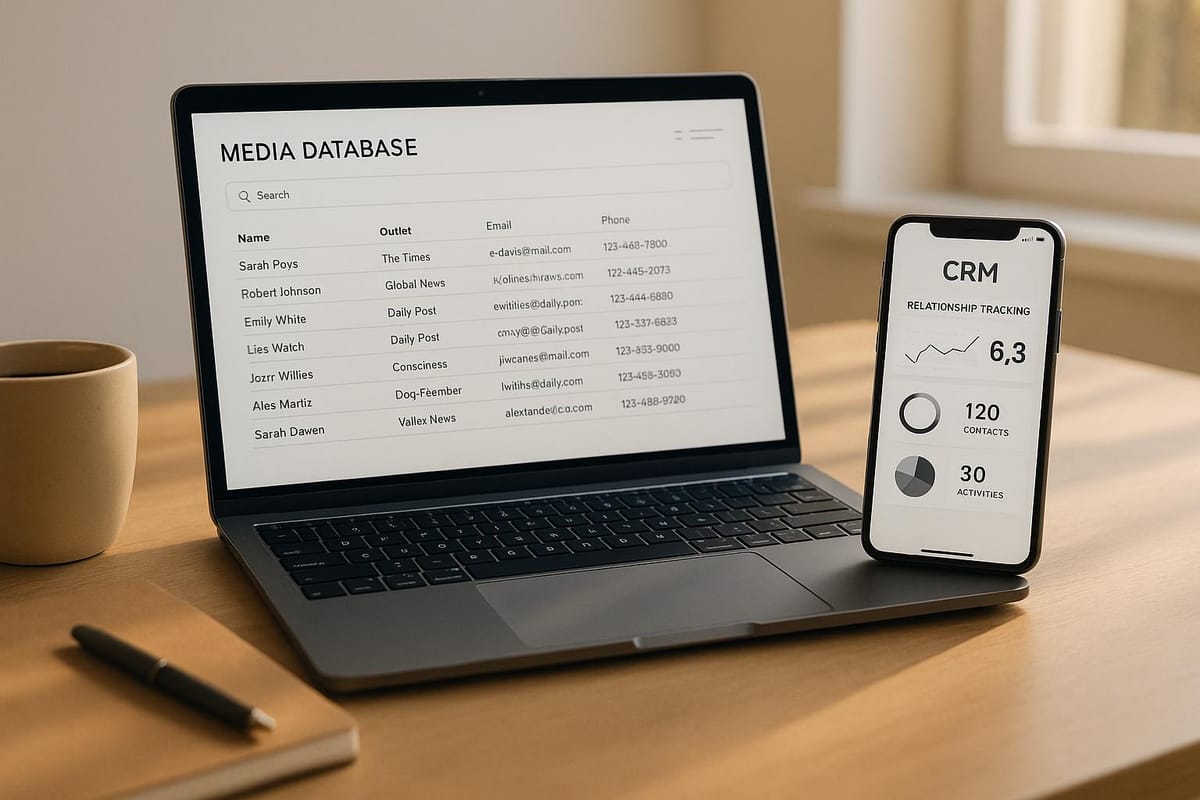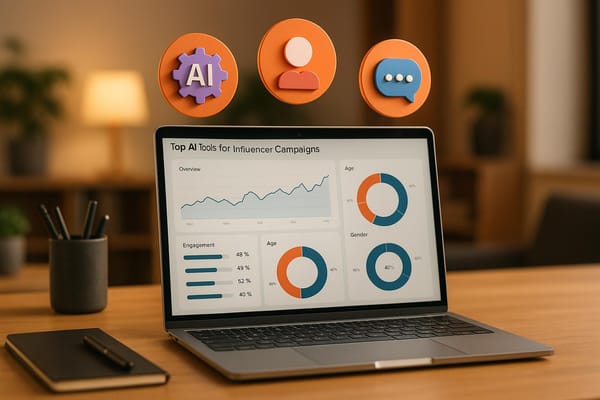Media Database vs CRM: Which Tool for PR Teams?
Explore the differences between media databases and CRMs for PR teams to optimize outreach and relationship management strategies.

Struggling to choose between a media database and a CRM for your PR team? Here’s the quick answer:
- Media databases are perfect for finding journalists and influencers quickly. They provide access to large, regularly updated contact lists and allow targeted searches based on beats, outlets, and locations.
- CRMs are ideal for managing relationships. They track interactions, organize contacts, and help teams personalize outreach for long-term engagement.
Key takeaway: Media databases are best for discovery, while CRMs focus on relationship management. Many PR teams use both tools together for maximum efficiency.
Quick Comparison
| Feature | Media Database | CRM for PR |
|---|---|---|
| Contact Discovery | Built-in, 30,000+ contacts | Manual input required |
| Data Accuracy | Continuously updated | Requires manual updates |
| Relationship Tracking | Limited | Comprehensive |
| Outreach Automation | Export contacts only | Built-in tools |
| Team Collaboration | Basic | Advanced |
| Pricing | $99–$149/month | $50–$300+/user/month |
When to choose:
- Use a media database for quick outreach and campaign launches.
- Use a CRM to build and maintain long-term relationships.
- Combine both tools for the best of both worlds.
Keep reading to see how these tools work, their features, and how to pick the right one for your team.
How To Pick The Right CRM Tools
Media Databases: Features and How PR Teams Use Them
Media databases play a crucial role in PR outreach, equipping teams with tools to find, research, and connect with the right media contacts. These platforms have come a long way from being simple directories, now integrating AI-powered features that make it easier to discover journalists and tailor pitches to their preferences.
Main Functions of Media Databases
Media databases are built for thorough contact discovery and management. Many platforms host vast directories - some boasting over 1.1 million contacts. For instance, Media AI offers PR professionals access to more than 30,000 journalists and creators through its AI-driven platform, ensuring a focused and regularly updated resource.
One standout feature is the ability to conduct advanced searches with filters. PR teams can refine their searches by journalist name, beat, outlet, location, job title, or even keywords from recent articles or social media posts. This level of detail allows teams to shift from broad, generic outreach to highly targeted and relevant pitching.
Modern platforms also provide in-depth journalist profiles. These profiles include areas of expertise, recent work, social media activity, and preferred communication methods. Considering that 96% of journalists use social media professionally, having up-to-date social media details helps PR teams craft pitches that resonate.
Another helpful feature is the ability to export and manage contact lists. Tools like Media AI make it easy to organize contacts into campaign-specific lists and export them seamlessly, streamlining the transition from research to outreach.
These features make media databases an essential tool for PR teams during campaign planning and execution.
How PR Teams Use Media Databases
PR teams rely on media databases extensively during the research and discovery phases of their campaigns. Whether it's a product launch or a major announcement, these tools quickly identify the most relevant journalists, allowing teams to create targeted lists in just minutes.
In high-pressure situations, such as crisis communications, media databases become even more critical. They help teams quickly locate and contact journalists who have previously covered related topics. These platforms are equally valuable for event promotion, product launches, or sharing thought leadership by pinpointing reporters whose recent work aligns with the story angle. This targeted outreach is essential, as 75% of journalists block pitches that aren't relevant.
Beyond outreach, media databases support relationship-building efforts. Teams can track journalist preferences, log successful interactions, and gain insights into each contact's focus and communication style. This helps establish long-term, meaningful connections with members of the media.
Benefits of Media Databases
One of the biggest advantages is saving time. Instead of manually researching journalists across platforms, PR teams can quickly compile comprehensive media lists, leaving more time to focus on crafting impactful pitches.
Another major benefit is data accuracy. Platforms like Agility PR claim 99.6% overall data accuracy and 96% accuracy for direct email addresses. AI-driven tools such as Media AI go a step further by continuously updating and verifying contact information, ensuring that teams always have access to the most current data.
Cost is also a factor. Media AI offers flexible pricing, starting at $99 per month for specialized databases and $149 per month for full access. This pricing structure eliminates the need for long-term contracts, making high-quality data accessible to teams of all sizes.
AI-powered features are another game-changer. These systems can scan thousands of contacts and match PR professionals with the reporters most relevant to their press releases. This ensures pitches are sent to the right people, increasing the chances of success.
Lastly, collaborative tools within these platforms allow entire PR teams to work from a shared, up-to-date contact repository. By sharing notes and coordinating outreach efforts, teams can maintain consistent messaging and avoid duplicate communications. These benefits make media databases an indispensable part of any PR toolkit.
CRMs for PR: Features and How PR Teams Use Them
CRM systems tailored for PR teams are specifically designed to tackle the unique challenges of media relations and communications. Unlike generic CRM tools, these systems are built to manage the complexities of media outreach and the demands of public relations work.
Main Functions of CRMs
PR-focused CRMs come with features that go beyond what standard business CRMs offer. At their core, these systems excel in contact management, helping teams maintain relationships with journalists, bloggers, influencers, and media outlets.
Another key feature is outreach planning and automation. These tools can handle repetitive tasks like sending follow-up emails and setting reminders, ensuring consistent communication without manual effort.
Interaction tracking is also a standout capability. PR CRMs log every interaction with media contacts - from initial pitches to follow-ups - creating a detailed record of each relationship. This not only helps teams analyze campaign performance but also ensures no detail is overlooked.
Collaboration tools are another essential component. PR CRMs provide a shared platform where team members can track who has contacted which journalist, what was discussed, and when follow-ups are scheduled. This prevents duplicate efforts and keeps everyone on the same page.
Modern PR CRMs also include segmentation tools, allowing teams to group contacts by industry, beat, location, job title, or client status. This makes it easy to create highly targeted campaigns, avoiding the inefficiency of sending generic pitches to large, untargeted lists.
How PR Teams Use CRMs
PR teams rely on CRMs to manage relationships and personalize their outreach. By building detailed profiles of media contacts - including their interests and communication preferences - teams can engage with journalists on a more individual level.
These systems also help coordinate campaigns, whether it's a product launch or a crisis response. With a CRM, teams can ensure consistent messaging and tailor interactions based on each journalist's history with the brand.
Performance tracking is another critical use. PR CRMs can show which pitches led to coverage, analyze response rates across journalist groups, and measure overall campaign success. This data allows teams to refine their strategies and prove their impact to clients and management.
Long-term relationship building is a major focus of PR CRMs. Unlike sales CRMs, which often prioritize short-term transactions, PR systems are designed to nurture relationships over time. They help teams remember key details about journalists and maintain connections, even during quieter periods.
Benefits of CRMs in PR
PR CRMs offer several advantages that make them indispensable for modern PR teams. For starters, they improve team coordination. With 60% of PR teams still relying on spreadsheets, a centralized system eliminates confusion and prevents multiple team members from contacting the same journalist.
These tools also enable personalized outreach. By segmenting contacts and tailoring campaigns to each journalist’s interests and beat, teams can avoid the pitfalls of generic pitches, which are often ignored.
Another major benefit is centralized, accurate data. With business contact data decaying at an average rate of 22.5% annually, keeping information current is critical. PR CRMs help by centralizing contact details, often with features that verify and update information automatically.
By automating routine tasks and streamlining collaboration, PR CRMs free up time for professionals to focus on building meaningful media relationships. They also enhance campaign measurement, helping teams identify what works best with different types of media contacts.
For PR teams managing multiple clients or campaigns, these tools transform a traditionally manual process into a more organized, measurable, and effective approach. Whether it’s tracking performance, coordinating efforts, or maintaining strong relationships, PR CRMs provide the structure needed to succeed.
Media Database vs CRM: Direct Comparison
Balancing discovery and relationship management is key to a successful PR strategy. This comparison explores how media databases and CRMs serve these needs, helping you decide which tool - or combination - is right for your goals.
Feature Comparison: Media Database vs CRM
Media databases and CRMs cater to different aspects of PR workflows, and their features reflect these distinctions:
| Feature | Media Database (Media AI) | CRM for PR |
|---|---|---|
| Contact Discovery | Access to a database of 30,000+ journalists and creators | Contacts must be added manually |
| Contact Information | Continuously verified and updated | Manual updates required; data decays at 22.5% annually |
| Relationship Tracking | Basic profiles only | Tracks all interactions comprehensively |
| Outreach Automation | Export contacts for external tools | Built-in email automation and follow-up sequences |
| Team Collaboration | Individual access | Shared workspaces and team coordination tools |
| Campaign Tracking | Limited tracking options | Detailed performance analytics and ROI measurement |
| Pricing | $99-$149/month, no long-term contracts | Varies widely, often $50-$300+ per user/month |
| Learning Curve | Easy to use right away | Requires setup and training time |
Media AI stands out with its vast, up-to-date database of over 30,000 verified journalist profiles. This eliminates the hassle of manually searching for contacts - a pain point for nearly 60% of PR professionals who rely on outdated spreadsheets.
CRMs, by contrast, are built for fostering relationships. They track interactions, enabling teams to personalize outreach based on previous conversations, which is crucial for long-term engagement.
Understanding these differences highlights where each tool fits into your PR strategy.
Pros and Cons of Each Tool
Media Database Advantages:
Media databases like Media AI are perfect for quickly identifying and contacting new journalists, especially during campaign launches. Their continuously updated information reduces the risk of bounced emails or outdated phone numbers. The pricing model - $99-$149 per month without contracts - makes them accessible for smaller teams or agencies that need flexibility. Plus, they require minimal setup, so you can start using them right away.
Media Database Limitations:
While great for discovery, media databases fall short on relationship management. They lack tools to track communication history or capture details like a journalist’s preferences, which are essential for building lasting connections.
CRM Advantages:
CRMs excel at personalizing outreach and maintaining long-term relationships. As Alex Slater, founder and managing director of Clyde Group, explains:
"The core of public relations is relationship building, and it's based on a mutual respect between journalists and PR practitioners."
CRMs help by tracking every interaction, ensuring you can tailor future communication effectively. They also enhance team collaboration, preventing overlap when multiple team members work on the same contact.
CRM Limitations:
However, CRMs aren’t ideal for discovering new contacts. Adding media contacts manually can be tedious and may result in incomplete or outdated information. Their setup and learning curve can also delay their effectiveness.
Weighing these strengths and weaknesses can help you determine which tool aligns with your team’s needs.
When to Use Each Tool
Choose a Media Database When:
If your focus is on launching campaigns and discovering contacts quickly, a media database like Media AI is your best bet. It’s especially useful for agencies juggling multiple clients across industries, as it provides instant access to a wide range of journalist profiles without the need to maintain separate lists.
Choose a CRM When:
CRMs are ideal for nurturing relationships and managing ongoing communication. They’re particularly valuable for complex campaigns that require tracking multiple interactions and coordinating team efforts. Maintaining relationships with existing contacts can boost success rates to 70%, compared to just 20% when reaching out to new contacts.
The Hybrid Approach:
Many PR teams find success by combining both tools. Use Media AI for discovering new contacts and then transfer them into a CRM for ongoing relationship management. This hybrid approach ensures you can efficiently source contacts while maintaining personalized, long-term engagement - a winning strategy for any PR campaign.
How to Choose the Right Tool for Your PR Team
The tools you pick for your PR team can either streamline your workflow or slow you down. The key is to match the tool to your team’s needs, budget, and goals.
What to Consider When Choosing
Team Size and Collaboration Needs are essential factors. If you’re working solo or part of a small team, tools like Media AI, priced at $99–$149 per month, offer simplicity and access to over 30,000 verified contacts. Larger teams might require platforms with more advanced features, but smaller teams benefit from a straightforward approach.
Data Quality Requirements should never be overlooked. With B2B data decaying at an annual rate of 22.5%, keeping your contact list accurate is critical. Media AI stands out by continuously verifying and updating its database, ensuring your outreach efforts remain effective.
Budget Considerations go beyond just the monthly subscription fee. For instance, while Media AI offers transparent pricing without long-term contracts, many CRMs come with extra costs for setup, training, and ongoing maintenance. Factor in these hidden costs when making your decision.
Integration with Existing Systems is another key point. If you already use tools like email marketing software or project management platforms, check if your chosen tool can work seamlessly with them. Media AI, for example, allows easy data exports, making it adaptable to your existing workflow. On the other hand, CRMs often require more complex integration efforts.
Campaign Goals and Timeline should guide your choice. For time-sensitive campaigns that demand quick access to contacts, Media AI’s instant database can be a game-changer. However, if your focus is on long-term relationship-building, CRMs provide better tracking and engagement tools. Many PR teams find value in using both tools together to address different needs.
Using Both Tools Together
Combining Media AI and a CRM often delivers the best results, allowing PR teams to leverage the strengths of each platform.
Start with Media AI to identify and connect with potential contacts. Then, selectively transfer high-priority relationships - like journalists covering your niche topics - into your CRM for ongoing management. This approach keeps your CRM organized while ensuring your most important contacts get the attention they deserve.
Automation can also save time. PR professionals using a CRM to manage contacts report saving an average of two hours per week compared to those relying on spreadsheets. However, this benefit applies mainly to the contacts you’re actively engaging with, not your entire database.
By taking this hybrid approach, you can balance broad outreach with deeper relationship management. Media AI helps with quick discovery and outreach, while the CRM is ideal for nurturing key relationships over time.
Our Recommendation
Here’s how to decide which tools are right for your PR team:
- For new PR teams or those launching their first campaigns, Media AI is a great starting point. Its $99–$149 monthly pricing and no-contract model make it accessible and efficient. You’ll get verified contacts and can begin outreach immediately while figuring out if additional CRM features are necessary.
- For established teams with ongoing media relationships, evaluate your current processes. If you’re already managing journalist interactions and running complex campaigns, a CRM might justify its higher costs. Even then, Media AI can complement your efforts by simplifying contact discovery.
- For agencies managing multiple clients, a hybrid approach works best. Media AI provides broad access to contacts across various industries, while a CRM helps track client-specific relationships and campaign details.
On average, successful organizations allocate 10–20% of their marketing budget to PR activities. Use this budget wisely by focusing on tools that solve your biggest challenges. If finding accurate contacts is your pain point, Media AI is the answer. If managing ongoing relationships is more critical, prioritize CRM capabilities.
The bottom line? Choose tools that enhance productivity and eliminate unnecessary headaches. Start with your most pressing need and expand your toolkit as your team and goals evolve.
FAQs
Should my PR team use a media database or a CRM?
When deciding between a media database and a CRM, it all comes down to what your PR team values most. If your primary goal is connecting with journalists and identifying the right media outlets, a media database is the way to go. These tools are packed with extensive directories of media contacts and help simplify your outreach process.
On the flip side, if your focus leans more toward managing relationships, planning campaigns, and monitoring PR performance, a CRM is a better match.
In reality, many teams find that combining both tools offers the best of both worlds. To make the right choice, start by assessing whether your team needs more help discovering media contacts or managing relationships and campaigns. From there, align your decision with your workflow and objectives.
Can combining a media database and a CRM improve my PR strategy?
Using a media database alongside a CRM can take your PR strategy to the next level by simplifying processes and delivering better outcomes. A media database helps you find and reach out to the right journalists and influencers, while a CRM is ideal for managing ongoing relationships and keeping track of every interaction.
When these tools work together, you can tailor your outreach, monitor the progress of your campaigns, and nurture stronger connections with media contacts. This synergy empowers PR teams to work more efficiently and boost their chances of securing impactful media coverage and successful campaigns.
What are the costs and benefits of using a media database versus a CRM for PR teams?
When it comes to PR tools, a media database can be a more budget-friendly option for teams focused on media outreach and building relationships with journalists. These platforms usually require a subscription fee, giving you access to large media contact lists and coverage data. This can save a lot of time compared to doing all the research manually.
In contrast, CRMs tend to be pricier, often charging per user on a monthly basis. But they offer more than just contact management - they include features like campaign tracking, advanced analytics, and tools for managing relationships on a broader scale. These capabilities make CRMs a smart choice for teams handling complex campaigns or maintaining long-term client connections.
The best option depends on what your team needs. Media databases are great for focused outreach efforts, while CRMs offer a more comprehensive solution for managing PR workflows and long-term strategies.





